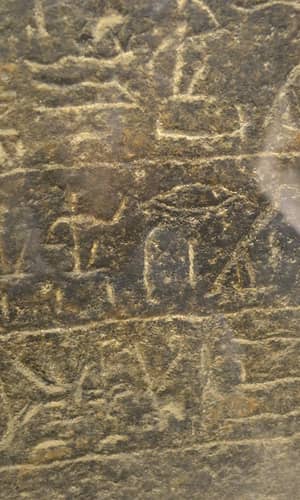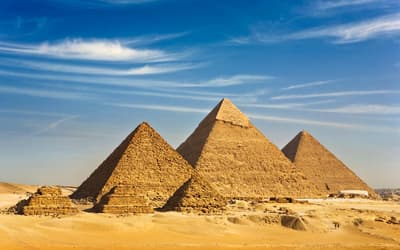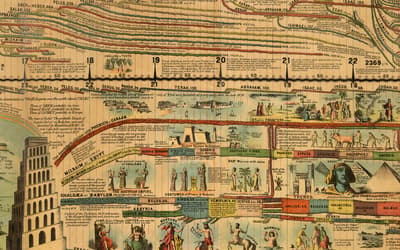The views expressed in this paper are those of the writer(s) and are not necessarily those of the ARJ Editor or Answers in Genesis.
Abstract
In this paper we will show that the biblical and Egyptian chronologies produce timelines that diverge greatly back before about 600 B.C. This has important implications for interpreting archaeological findings, which are usually published with Egyptian dates, and no indication is given that the biblical dates might be different. The result is claims that the Bible is wrong, or even that events like the Exodus never happened at all, because scholars are looking for these events in the wrong place in time. This produces widespread disbelief in the authority of the Bible, making chronology a crucial branch of biblical apologetics. We therefore need to apply solid scholarship to the subject of synchronizing the biblical and Egyptian timelines, because there is a lot at stake—the very foundations of our belief system are in question. The synchronization of the two timelines laid out here will show where scholars should look for biblical events on the Egyptian timeline and, conversely, Egyptian events on the biblical timeline.
Introduction
The subject of the Egyptian chronology,1 also called the standard chronology, comes up constantly with respect to the Bible. Because it is widely (and I believe incorrectly) thought that the two timelines coincide in historical times (defined roughly from Abraham forward to 600 B.C.), secular as well as many biblical scholars do not distinguish between the two. Biblical and standard Egyptian dates are unfortunately treated as if they are the same, with much confusion resulting. This has enormous consequences for interpretation of archaeology and history with respect to the Bible, as we will see.
Attempts at revising the Egyptian timeline to fit the biblical timeline have been made by various scholars over the years. Books by some of these authors from my own library are: Ashton and Down (2006), Courville (1971), Henry (2003), James (1993), Möller (2002), Osgood (2020), Rohl (1995), Stewart (2003), Sweeney (2008), and Velikovsky (2009, 2010). This is not an exhaustive list of books on the subject. Also, online research can turn up papers by many others; we cannot begin to list them all here. Clearly there are many differing ideas, some by Bible believers, and some by others who are not. But they all share one belief: something has to be done about the current standard Egyptian timeline.
How We Know That the Biblical and Egyptian Timelines Do Not Coincide
The theme that constantly gets played by liberal historians and archaeologists is that whatever biblical event they are looking for—the Exodus is an example—is not visible in history where they think it should be, wherever that is. Some even claim that the Exodus as described in the Bible never happened at all (for example, Finkelstein and Silberman who devote a whole chapter in their book, The Bible Unearthed, to this idea) (2001, 48–71).2
I submit that the reason for not finding evidences of something like the Exodus where they expect it in history is that scholars mistakenly assume that the biblical and standard Egyptian dates are the same. Many put their trust in the information produced by traditional archaeology. We quote from the well-known book by Finkelstein and Silberman (2001,5):
But that is not to say that archaeology has proved the biblical narrative to be true in all of its details. Far from it: it is now evident that many events of biblical history did not take place in either the particular era or the manner described. Some of the most famous events in the Bible clearly never happened at all.
And Finkelstein and Silberman (2001, 36):
The biblical stories should thus be regarded as a national mythology with no more historical basis than the Homeric saga of Odysseus’s travels or Virgil’s saga of Aeneas’s founding of Rome.
If the biblical and Egyptian timelines were the same, biblical events would show up in secular Egyptian history where expected. But they do not, as archaeologists like Finkelstein and Silberman show. This constitutes a strong reason for looking for synchronization points where events that occur both in the Bible and in Egyptian history coincide.
Another area that gains the trust of scholars is radiocarbon dating. As I wrote in my first paper on the chronology of Egypt (Habermehl 2013a):
According to Levy et al. [2005], the real salvation of chronology will be radiocarbon dating, a science for which they have great enthusiasm; and reliability of the Bible—or lack of it—will be measured by this dating yardstick . . . In their view, radiocarbon dating supersedes biblical chronology. Clearly we need to be careful of accepting secular radiocarbon dating, which has its own presuppositions and accuracy constraints.
If archaeology and radiocarbon dating produce dates that differ from biblical dates, these people claim that the Bible must be wrong. Oddly, it never seems to occur to them that it could be their standard Egyptian chronology that could be wrong.
Although this paper will show that the standard Egyptian timeline is stretched out relative to the biblical one, and biblical events took place farther back in Egyptian history than is commonly believed, the opposite of this belief is currently popular among liberal scholars. These people claim that the patriarchs and following events actually are situated more recently than the biblical timeline shows. An explanation of this is taken from Moore and Kelle (2011, 61):
An anachronism is a mistake in chronology in which a person, place, or object is placed in a period other than the proper one. Most often, anachronisms take the form of misplaced chronological references in which a reality that did not emerge until a later period is depicted as having existed in an earlier one. In historical study of biblical texts, such chronological errors have played a key role in the attempt to date textual sources and establish their proximity to the events they describe. In the patriarchal narratives, the observation of anachronisms . . . led many historians to conclude that the stories originated in a period that was significantly later than the literary setting that was presented in the text.
In other words, although the Bible says that Abraham lived in very ancient times, these historians say that he actually lived more recently. For an in-depth discussion of modern scholarship on this subject, readers are referred to this book (Moore and Kelle 2011).
The very authority of our Bible is under attack because scholars place their confidence in archaeology, carbon dating, and other modern beliefs rather than in Scripture itself. This is a serious matter because biblical authority is the underlying support for our faith and our entire worldview, and these people are trying to tear our biblical beliefs apart. We need to be ready to defend the historicity of the Bible with answers. Those answers will come from showing these unbelieving scholars that proper synchronization of the biblical and Egyptian timelines explains that our literal belief in the Bible is well founded.
Scope of This Paper: Why Synchronize the Egyptian Timeline With the Biblical One
The reason for choosing Egypt for this project of correlating timelines is because it is mentioned over 700 times in the Bible, far more than any other country foreign to Israel/Canaan (Kaltner 2021).
Clearly there are countries other than Egypt that appear in the Bible, that have their own secular histories that we also need to synchronize with the biblical timeline. However, we cannot work on all of them at once. If we try to include Assyrian and Babylonian and Hittite3 and other countries’ dates all at the same time in our synchronization of history with the Bible, this becomes an almost impossibly complex task.
We are therefore setting out here to produce an Egyptian-versus-biblical history correlation that is solid. All other countries’ histories will then have to fit this one. If they do not fit this synchronization, it will be necessary to work out what the problems are. This will be a task for the future.
Why the Biblical and Egyptian Historical Timelines Are Different
The short answer is that these two timelines were developed independently in different ways at different times by different people.
The biblical timeline comes from time information contained in the Bible. This includes facts such as how many years have passed (for example, how long the Children of Israel were in Egypt), how old someone was (for example, Abraham’s age when Isaac was born), or how long kings reigned.
On the other hand, the Egyptian timeline originally comes to us from Manetho, an Egyptian priest of the third century B.C., who took information available to him on how long the known pharaohs claim to have reigned, and then laid them all end to end (Shaw 2003, 1). His timeline has been shortened considerably over the years by scholars who have meddled with it,4 but in its current state it is the timeline used and published today by all secular historians and archaeologists.5 Right from the start we should be wary of this timeline because of its secular origins.
Because of the differing ways that these two timelines were developed, there is no reason why we should expect them to coincide. Indeed we might wonder why anyone thinks that they would. As we show in this paper, in the historical period (from Abraham on) secular dates from the Egyptian timeline are a great deal older than biblical dates. As an example, Solomon reigned around 1000 B.C. (biblical) (Jones 2004, 279), but this corresponds to nearly 1500 B.C. on the Egyptian timeline (Habermehl 2018a). Secular scholars should therefore be looking for Solomon’s kingdom back around 1500 B.C. on their timeline. No wonder they don’t believe what the Bible says about that kingdom—they are nearly 500 years off in where they are looking for it. For instance, they look in vain for evidence of Solomon’s glories as described in 1 Kings 10. Finkelstein and Silberman devote a chapter in The Bible Unearthed (2001, 123–145), to carefully explain why archaeology shows that the biblical story of David and Solomon’s kingdom is not true. Their conclusion (2001, 145):
As we have seen, the historical reality of the kingdom of David and Solomon was quite different from the tale.
By “the tale” they mean the biblical narrative. They go on to promise us “a very different Israel” (Finkelstein and Silberman 2001, 145). In short, based on their archaeology, they claim that the Bible is incorrect, and they will give us the “real” story.
But we do not want a different Israel than the one that the Bible describes because we believe that the Bible is authoritative. We will therefore hold firmly to the biblical timeline, and will do whatever is necessary to force the (unreliable) standard timeline of Egypt to fit the biblical one.
Definition of “Historical Times,” and the Jones Versus Thiele Chronologies
We will define “historical times” to begin with Abraham’s father, Terah, born 2126 B.C. on the biblical timeline (Jones 1993, 278) or about 3500 B.C. on the standard timeline (see Habermehl 2013a: this date is estimated from the stretching out of the Egyptian timeline). This point in history is chosen because there is a blank in the biblical historical narrative between the Babel dispersion and Abraham’s father, Terah (Genesis 11). Also, we point out that the Septuagint versus Masoretic versions of the Bible do not come into this timeline discussion, because the differences in the length of their respective genealogies only come into play before Abraham’s grandfather, Nahor, Terah’s father (Genesis 11:24, 25).
The Jones biblical chronology is mainly used in this paper (Jones 2004); this chronology has the advantage of covering the entire history of the world from creation to about 100 years after the birth of Christ. It is understood that the other well-known biblical chronology is that of Thiele (1994); however his chronology is limited in that it covers only the period of the kings of Judah (931 B.C. to 586 B.C.) and the kings of Israel (931 B.C. to 722 B.C.) (see Thiele 1994, 217). The differences between these two chronologies are not great in the general scheme of things; as an example, Jones and Thiele date Ahab’s accession to the throne only 44 years apart (Jones 2004, 279; Thiele 1994, 10).6
How We Will Approach Setting Up Synchronization of the Biblical and Egyptian Timelines
We will draw two timelines opposite each other, biblical and Egyptian standard, and will show connecting points between them. Those synchronizations will be where people or events of the Bible correspond to people or events of Egypt. See fig. 1 for this drawing, which will be referenced throughout this paper.

Fig. 1. The biblical and Egyptian timelines showing the seven synchronizations outlined in this paper. The lower biblical timeline is a straight line, while the upper Egyptian standard timeline is strangely shaped because of the variations in its divergence from the biblical timeline. The distance between the two lines at any point is the amount of divergence and is shown approximately in proportion. Drawing by A. Habermehl 2021.
I include crossover points between the two timelines that are solid and well supported. There are not as many of these provable crossover points between Egypt and the Bible as we might think. In Table 1 we list the seven that we will use, and will then lay out the logic behind each of them. These explanations will necessarily be brief to keep this paper from being overlong, as it could easily stretch out to book length if these points were pursued in detail here. More extensive support for these synchronizations is explained in the referenced papers, and it is recommended that these papers be read as background; all are online.
| Abraham in Egypt in First Dynasty |
| Joseph = Imhotep (vizier of Djoser in Third Dynasty) |
| Exodus and Amenemhat IV |
| Solomon and his father-in-law, Thutmose III. |
| Rehoboam and Shishak (Amenhotep II) |
| Twelfth century B.C. collapse of nations. |
| Josiah and Necho II. |
We will now examine these synchronizations, each in turn.
1. Abraham in Egypt: About 1920 B.C. Biblical Timeline, 3000 B.C. Standard Egyptian Timeline. Divergence: c. 1100 Years
This first (earliest) synchronization point between the biblical and Egyptian timelines depends on finding the place in Egyptian history where Abraham appears.
Some time after Abraham moved from Haran to Canaan, there was a severe famine in Canaan that made him decide to travel with all that he had to Egypt (Genesis 12:10–20). It is important to note that this famine occurred in Canaan but not in Egypt, as there is no biblical mention of famine in Egypt at that time. Although Egypt and Canaan are not geographically far apart, the condition that usually brought on famine in Egypt was a low Nile flow, which meant low rainfall far to the south in Africa where the Nile originates (see Habermehl 2013b). On the other hand, famine in Canaan was the result of low rainfall in Canaan itself. In any case, it is unlikely that Abraham would travel from one area that is under severe famine to another that is also under famine. This Genesis 12 famine in Canaan therefore cannot be synchronized with any of the various known Egyptian famines, as is claimed by some.7, 8
In Egypt, Abraham dealt with a powerful unnamed king or pharaoh, whom he clearly feared. That is why Abraham told the pharaoh that Sarah was his sister, so that the pharaoh would not kill Abraham to take her as his wife. Because this pharaoh was so powerful, we know that Egypt must have been united by this time after the Predynastic period, and was now under the rule of the dynastic pharaohs. But which one?
We can determine Abraham’s approximate place in Egyptian history by first establishing Joseph as Imhotep, vizier of the Pharaoh Djoser of the Third Dynasty (see the next section of this paper). The time between Abraham’s visit and Joseph’s becoming vizier would be about 200 years on the biblical timeline; Abraham left Haran in 1921 B.C., and Joseph was promoted in 1715 B.C. (Jones 2004, 278). But the difference between the biblical and standard Egyptian timelines is stretching out at this time as we see in fig. 1, and so we can date Abraham before Joseph a lot more than 200 years on the Egyptian timeline. For this reason we would put Abraham in Egypt around 3000 B.C. or so, in the early part of the First Dynasty (Shaw 2003, 481).9
There is a known historical reason to back up our placement of Abraham in Egypt in the early First Dynasty. At this period, there was a lot of traffic in goods between Egypt and Canaan, with colonies of Egyptians living in southern Palestine since Dynasty 0. These Egyptians returned home to Egypt at the end of the reign of King Aha (or Hor-Aha), considered the first pharaoh of the First Dynasty by many scholars. Historians tell us that this migration from Canaan back to Egypt happened, but do not say why (see Porat 1992; Raffaele 2003; Watrin 1998, 1224–1226.) We might wonder whether this exodus from Canaan was because of the same severe famine that drove Abraham to Egypt. These Egyptians would have needed a very strong reason for them to interrupt their prosperous trade and make such a major move. (See fig. 2, the serekh of King Aha.)

Fig. 2. Serekh (royal crest) of Pharaoh Aha, who was reigning during the First Dynasty at the time that Egyptians living and doing business in Canaan moved back to Egypt. It is on a glazed fragment of a faience vessel, found at the temple of Osiris at Abydos. Captmondo. “Faience vessel fragment with serekh inscribed with the Horus-name “aha”, on display at the British Museum,” https://en.wikipedia.org/wiki/Hor-Aha#/media/File:GlazedFiaenceVesselFragmentNameOfAha-BritishMuseum-August21-08.jpg. CC BY-SA 3.0.
This would make the divergence between the biblical and standard timelines at the time of Abraham’s visit to Egypt around 1,100 years.
One of the implications of this date for Abraham is that it puts the destruction of Sodom back to 3000 B.C. on the archaeologists’ standard timeline. If there are any archaeological remains of Sodom, they should be on the west side of the Jordan River just above the Dead Sea, and they should date to this time. For more on this, see my pair of papers on Sodom (Habermehl 2017a, 2017b).
The allied kings of Genesis 14:1, who fought the kings of the land of Sodom, also need to be sought in this time frame of the early First Dynasty. Abraham enters this story when he rescues his nephew, Lot, from these kings (Genesis 14:13–16).
2. Joseph as Imhotep: 1715 B.C. Biblical Timeline, 2665 B.C. Standard Egyptian Timeline. Divergence: c. 950 Years
Where Joseph appears in Egyptian history is a controversial matter among scholars, who offer varying opinions. For instance, Courville (1971, vol. 1, 141–142) concludes that Joseph is Mentuhotep, second vizier to Twelfth-Dynasty Sesostris I. Osgood agrees with Courville (Osgood 2020, 204). Stewart (2003, 90–103) believes that Joseph was an unnamed first vizier to Sesostris I. Aling (2003) chooses Sesostris II as Joseph’s pharaoh. Smith (1948, 505) favors one of the Hyksos kings, possibly Apophis, as Joseph’s pharaoh. Bates et al. also point to Joseph under a Hyksos king (2020, 62–64).10
Ten years ago, when I published a paper on Egyptian chronology (Habermehl 2013a), I showed why Joseph had to have been the same person as the ancient famed Imhotep, vizier of the pharaoh Djoser of the Third Dynasty of the Old Kingdom. Although I had come to this conclusion on my own, I found that the equivalence of these two persons was not a new idea on my part, as others had thought of it before. The earliest source I found was Tom Chetwynd, who wrote a scholarly paper on the subject in 1987 (Chetwynd 1987, 49–56 ). See fig. 3, statue of Djoser.
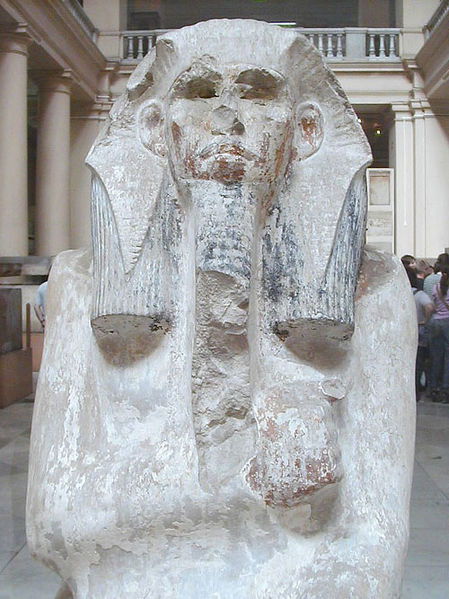
Fig. 3. Limestone statue of Third-Dynasty Pharaoh Djoser, Joseph’s pharaoh, from his funerary temple in Saqqara. Egyptian museum. Jon Bodsworth, “Djoser statue, 3rd Dynasty Egyptian Museum (JE 49158),” https://commons.wikimedia.org/wiki/File:Djoser_statue.jpg. Copyrighted free use.
This synchronization supports Abraham in the era of the First Dynasty, as I show in section no. 1 above. It also allows us to place the Exodus at the end of the Twelfth Dynasty, as I show in synchronization no. 3 below.
The evidences for Joseph as Imhotep were clear enough. These started with the obvious one, that phonetically “Joseph” and “. . . hotep” sound similar in English, in spite of their differing language origins (Hebrew and Egyptian). Other comparisons of Joseph to Imhotep are taken from the extensive discussion on this subject in my paper (Habermehl 2013a):
Both advised the pharaoh on dealing with a seven-year famine.
Both possessed great wisdom.
Both were seers.
Both had a lifespan of 110 years.
In addition, there are historical reasons that back Joseph as Imhotep. It was in Djoser’s time that pharaohs suddenly could conscript non-slave manpower to do great projects, such as building pyramids (for example, McClellan and Dorn 2006, 42–46). Also we see that the pharaohs of the Old Kingdom had become very wealthy, which enabled them to pay for these projects. Both of these items support Joseph as Imhotep, because the Bible explains clearly how Joseph made these things possible for his pharaoh (Genesis 47:13–26). During the seven years of plenty, Joseph instituted a rule that a fifth of all the grain grown in Egypt was to belong to the pharaoh. During the seven years of famine, the people ended up selling their land and themselves to the pharaoh in exchange for food. Because the pharaoh personally owned all the people, he had the power to require labor from them. There is also an inscription on a stela on Sehel Island, Egypt, that describes a famine in the time of Djoser, and a figure much like Joseph who aided the pharaoh (Lichtheim 1980, 94).
While writing the paper on Joseph as Imhotep, my research showed that there were naysayers, who considered that identifying Joseph as Imhotep was an idea to be disparaged (Habermehl 2013a). It is understandable that there would be resistance to the equating of these two men, because of the nearly thousand-year difference between them on their respective timelines. The various ways that this time discrepancy can be collapsed is discussed in that paper, and I will not go into that here (Habermehl 2013a). This includes showing that the Sixth and Twelfth Dynasties of Egypt had to have run concurrently, and that there was only one Intermediate Period, not two.
Recently I have run across another argument that claims to “prove” that Joseph cannot be Imhotep (Bates et al. 2020, 69 ). The argument runs like this: Joseph used a chariot to move around Egypt (Genesis 41:43). But chariots were first used in Egypt only much later on when the Hyksos introduced them; therefore Joseph (and his pharaoh) cannot have lived back in the Old Kingdom, but had to have been somewhere in the Fifteenth Dynasty under the Hyksos.
There are two problems with this claim. The first is that the widely held belief that chariots came into Egypt only with the Hyksos (see for example, Shaw 2003, 202) is not based on actual evidence. Because the Hyksos were buried with horses, it is widely assumed that the Hyksos also had chariots. But did they? As is stated by Herslund (2018, 151):
The Hyksos use of horse burials suggest that the Hyksos introduced both the horse and the chariot to Egypt, however no archaeological, pictorial, or textual evidence exists that the Hyksos possessed chariots . . .
When working out synchronizations between the biblical and secular timelines, it is risky to hang an argument on one claimed secular “fact” that may turn out not to be true at all. In this case, the claim that Joseph was under a Hyksos pharaoh is based on mere unproven speculation by historians that the Hyksos first introduced chariots to Egypt. (It says little for historians that they have widely leaped to this faulty conclusion without any evidence at all, and it certainly sets a trap for the unwary researcher.)
The second problem with the claim that Joseph cannot be Imhotep is that there is evidence that the Egyptians had chariots as far back as the Old Kingdom, which is when Imhotep was vizier under Djoser, pharaoh of the Third Dynasty. As stated by el-Arev (2013),
During routine archaeological research as part of the Ancient Egypt Leatherwork Project (AELP) carried out by Salima Ikram, Professor of Egyptology at the American University in Cairo (AUC) and Andre Veldmeijer, head of the Egyptology section at the Netherlands Flemish Institute in Cairo, a collection of 300 leather fragments of an Old Kingdom chariot were uncovered at the Egyptian Museum in Cairo.
Those Egyptian Tano chariot leathers are now claimed to be of unprovenanced (that is, unknown) origin and date (Herslund 2018, 200).
Chariots were already in use in very ancient times (at least 3000 B.C.) in other parts of the world, as shown by Piggott (1983, 239─240). There is a votive (model) two-wheeled chariot from Tell Agrab, dating from the first half of the third millennium B.C., in the Iraq museum in Baghdad (Margueron 1965, plate 45). (Dates here are secular.) It is unlikely that Egypt would not have known about chariots when other countries did. (The later Hyksos presumably could have had chariots if they had wanted them.)
It cannot therefore be proven that Joseph’s pharaoh did not have Egyptian chariots back in the Old Kingdom.
Also, Joseph’s pharaoh had to have been an Egyptian, and cannot have been a Hyksos. If Joseph’s pharaoh was not Egyptian, there would have been no need to mention that Egyptians detested shepherds (Genesis 46:34). It is precisely because this concern was raised that we know that the pharaoh was an Egyptian. Also, when Joseph was sold in Egypt, his master was Potiphar, an Egyptian, an officer of pharaoh, not a foreigner (Genesis 39:1). And when Joseph had his brothers dine with him (on their second visit to buy grain), there were three separate tables (Genesis 43:32). Joseph was at one, his brothers at another, and some Egyptians at a third. We might wonder why there were Egyptians dining with him? Why not Hyksos? The entire narrative backs Joseph’s pharaoh as an Egyptian.
Those who mistakenly place Joseph in the time of the Hyksos also bring the Exodus forward to the New Kingdom, to the reign of Amenhotep II, whom Bates et al. (2020, 75) claim is the pharaoh of the Exodus. Amenhotep II is going to come up again shortly in this paper, because I show that he is actually Shishak in synchronization no. 5 (Habermehl 2018a). Also, we will see who the pharaoh of the Exodus had to be in synchronization no. 3 immediately below.
3. The Primary Egyptian/Biblical Synchronization: The Exodus: About 1450 B.C. Biblical Timeline, 2200 B.C. and 1800 B.C. Standard Egyptian Timeline. Divergences of c. 750 and 350 Years.
The escape of the Children of Israel from Egypt described in Exodus 12 is mentioned often in scripture, and is a crossover point of prime importance. The date of the Exodus is the primary synchronization peg because it is pivotal in correlating the biblical and Egyptian timelines.
Having said this, the biblical date of the Exodus is highly contentious in scholarly circles. We are going to circumvent all of that here. As I said in my paper on revising the Egyptian chronology, “For all practical purposes, we shall accept 1450 BC as an Exodus date” (Habermehl 2013a). This date is considered conservative, and is based on taking 1 Kings 6:1 literally, where the number of years between the Exodus and the year Solomon started building the temple is given as 480 years.11
To determine where this biblical date is positioned on the Egyptian timeline, we need to look carefully at the history of ancient Egypt. We see that Egypt mysteriously collapsed twice: first at the end of the Sixth Dynasty (end of the Old Kingdom) and again at the end of the Twelfth Dynasty (end of the Middle Kingdom). The events succeeding both collapses are essentially the same. Historians have noticed this, but are at a loss to explain how this same sequence of events could have happened twice. Gardiner (1964, 147) tells us:
. . . it will be well to note that the general pattern of these two dark periods is roughly the same. Both begin with a chaotic series of insignificant native rulers; in both, intruders from Palestine cast their shadow over the delta, and even into the Valley; and in both relief comes at last from a hardy race of Theban princes, who after quelling internal dissension expel the foreigner and usher in a new epoch of immense power and prosperity.
If historians would look at the Bible, they would see that it is clearly the ten plagues that preceded the Exodus that caused Egypt to go into total collapse. But if so, the plagues had to have occurred at the end of both the Sixth and Twelfth Dynasties. How could this be? The explanation has to be that the two dynasties ran concurrently and ended at the same time. The pharaoh of the Twelfth Dynasty would have been ruling over Lower Egypt (the north), but would have also had power over the pharaoh of the Sixth Dynasty, who ruled Upper Egypt (the south) under him.
Arguments for placing the Exodus at the end of both the Sixth and Twelfth Dynasties of Egypt are made in my chronology paper (Habermehl 2013a). The main points are that the Exodus was the event that caused both of these dynasties to end at the same time; and there was only one Intermediate Period after these dynasties ended, not two, as commonly believed by historians. The amount of time covered by the secular Egyptian timeline is thus reduced considerably.
This sets two approximate Egyptian dates for the Exodus, 2200 B.C. and 1800 B.C. These two secular dates are both 1450 B.C. on the biblical timeline (obviously there was only one Exodus!). The difference between the secular and biblical dates for the Exodus is both 750 years and 350 years because of the concurrent Sixth and Twelfth Dynasties. This double dating for the Exodus gives our graph in fig. 1 an unusual shape.
The pharaoh of the Exodus would therefore have ruled near the end of the Sixth or Twelfth Dynasty, just before the collapse of Egypt. Because the Children of Israel lived in Goshen in the Delta in the north of Egypt, it would be a pharaoh at the end of the Twelfth Dynasty who would have been the pharaoh of the Exodus. As I argue in Habermehl (2013a), the pharaoh Amenemhat IV, who ruled as the second-last pharaoh of the Twelfth Dynasty, would most likely have been the pharaoh of the Exodus who drowned in the Red Sea. It is his mysterious disappearance from the space between Amenemhat III and Sobekneferu (the last pharaoh of the Twelfth Dynasty) in the king lists that points most strongly to Amenemhat IV.12 In addition, this pharaoh reigned for a fairly short time, and is poorly attested (Shaw 2003, 158). See fig. 4, small sphinx figurine of Amenemhat IV.
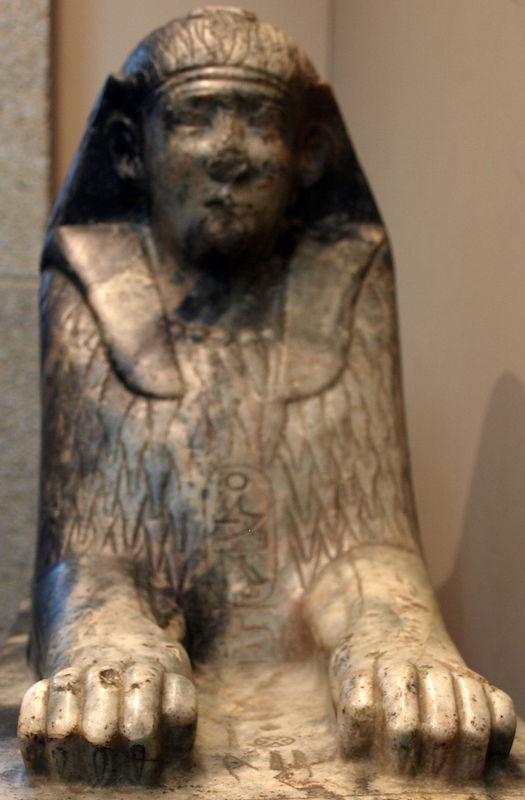
Fig. 4. Small gneiss sphinx is inscribed with the name of Amenemhat IV, the pharaoh of the Exodus. The face was reworked in later Ptolemaic times. Now on display at the British Museum. Captmondo, “Sphinx of Ammenemes IV (Amenemhat IV), made of gneiss, circa 1795 BC. Its face was reworked during the Roman period. EA 58892,” https://commons.wikimedia.org/wiki/File:AmmenemesIV(Front)-BritishMuseum-August19-08.jpg. CC-BY-SA-2.5.
Scholars who do not recognize the divergence of the Egyptian and biblical timelines either look in vain for the Exodus on the Egyptian (standard) timeline, or claim that the Exodus is in unlikely places. This is inevitable because they are many centuries out of step. We are saying that the Exodus had to have taken place about 2200 B.C. and 1800 B.C. on the Egyptian timeline (because of the two identical collapses of Egypt), whereas they are claiming Exodus dates anywhere between 1500 B.C. and 1100 B.C. on their Egyptian timeline.13
There is an ancient manuscript that supports these two dates of the Exodus on the Egyptian timeline. Called the Ipuwer Papyrus, it describes chaotic conditions in Egypt. Scholars are at odds as to whether it refers to the end of the Sixth Dynasty or the end of the Twelfth Dynasty. As I wrote in my paper about this papyrus, both sets of scholars are right (Habermehl 2018b). In addition, I showed that the Ipuwer Papyrus supports the biblical account of the Exodus because the events described in it parallel what happened as a result of the ten plagues of Exodus 7–12.
One Egyptian implication of the difference in the timelines is that the fourteenth-century pharaoh Akhenaten no longer is close to the time of Moses. Scholars debate whether Moses got his ideas on monotheism from Akhenaten (as an example, see Jack 2016). In fact, Moses would have lived centuries before Akhenaten, and the latter could possibly have gotten the idea of one god from Moses (we speculate here).
4. Solomon and His Father-in-Law, Thutmose III: About 1000 B.C. Biblical Timeline, 1470 B.C. Standard Egyptian Timeline. Divergence c. 470 Years.
Solomon concluded a treaty with an unnamed pharaoh of Egypt, and part of the agreement was that Solomon married a daughter of the pharaoh (1 Kings 3:1). In those days, when kings made treaties like this, it was common for one king to marry a daughter of the other king (Podany 2010, 84–86) to seal the deal. But this was an unusual marriage because although the pharaohs married other kings’ daughters, Amenhotep III claimed that it was never the other way around (Bryce 2014, 101–102). Clearly this unnamed pharaoh wanted something from Solomon and was willing to marry off his daughter to get it. We will see shortly what that might be.
This crossover between biblical and Egyptian history can only be determined chronologically if we know who this Egyptian pharaoh was. The Bible gives us a clue: the pharaoh destroyed Gezer, and generously presented the prize of the burnt-out city to the happy couple as a bride’s dowry (1 Kings 9:16). But like most cities in those ancient days, Gezer was destroyed several times, and the destruction that we are looking for here has to be chosen carefully.
Archaeologists describe a major destruction by Thutmose III in the fifteenth century B.C. (standard timeline) that I believe is the one most likely mentioned in the Bible (DeVries 1997, 176; Ortiz 2013, 468–474). This would have taken place at about 1000 B.C. (biblical timeline), with a divergence between the timelines of about 470 years. I devoted a paper to this subject (Habermehl 2018a). See fig. 5 for an object from the reign of Thutmose III.

Fig. 5. Glass chalice with the cartouche (name oval) of Pharaoh Thutmose III, Solomon’s father-in-law. captmondo, “Chalice with Name of Pharaoh Thutmose III (Thutmosis III).” https://commons.wikimedia.org/wiki/File:Chalice_with_Name_of_Pharaoh_Thutmose_III_-_18th_Dynasty_-_%C3%84S_630.jpg. CC BY-SA 3.0.
We might suspect that what Thutmose III wanted from Solomon was the right to travel with his army up and down along the eastern coast of the Mediterranean, along a strip on the west side of Solomon’s kingdom. This would have made a direct route possible from Egypt to Syria and the north for the many campaigns of Thutmose III (Shaw 2003, 237–239). It is interesting that this Egyptian pharaoh did not choose to go to battle and destroy Solomon’s kingdom but instead concluded a treaty with him. From a military and political point of view, we might infer that this was a clue to Solomon’s power.
5. Shishak as Amenhotep II: About 971 B.C. Biblical Timeline, 1418 B.C. Standard Egyptian Timeline. Divergence c. 450 Years
The campaign of Shishak took place in the fifth year of Rehoboam (1 Kings 14:25–26; 2 Chronicles 12:2) in 971 B.C. biblical (Jones 2004, 279). It is widely claimed that Shishak of the Bible was the pharaoh Sheshonq I (also spelled Soshenq), first ruler of the Twenty-second Dynasty (for example, Gardiner 1964, 329; Shaw 2003, 329). This is because of the linguistic resemblance of these two names, and because the dates of Sheshonq’s reign are about right if you accept the timelines as the same. But we have seen in no. 4 above that Solomon was close to 1470 B.C. on the standard Egyptian timeline; because Rehoboam ruled immediately after Solomon, we should be looking for Shishak closer to that date.
If Sheshonq I was not Shishak, then who was? Determining who Shishak was follows from the identification of Solomon’s father-in-law, Thutmose III, above. Shishak had to be the son of Thutmose III, Amenhotep II. This is supported by his Nebty name, that reduces to Shishak in its trip through Hebrew and English (Habermehl 2018a; Leprohon 2013, 7–9). Amenhotep II’s Nebty name is something that seems to have escaped the notice of scholars, presumably because they are looking for Shishak several hundred years later. The reign of Amenhotep II began in 1427 B.C. (Shaw 2003, 485). If his campaign against Jerusalem was in his ninth year (his last campaign, largely in Canaan), he would have raided Jerusalem in 1418 B.C. This makes the divergence between the two timelines 1418 minus 971, about 450 years, at this point. (We would expect this synchronization point to be very close to that of no. 4 above, Solomon and Thutmose III.) See fig. 6, statue head of Amenhotep II.
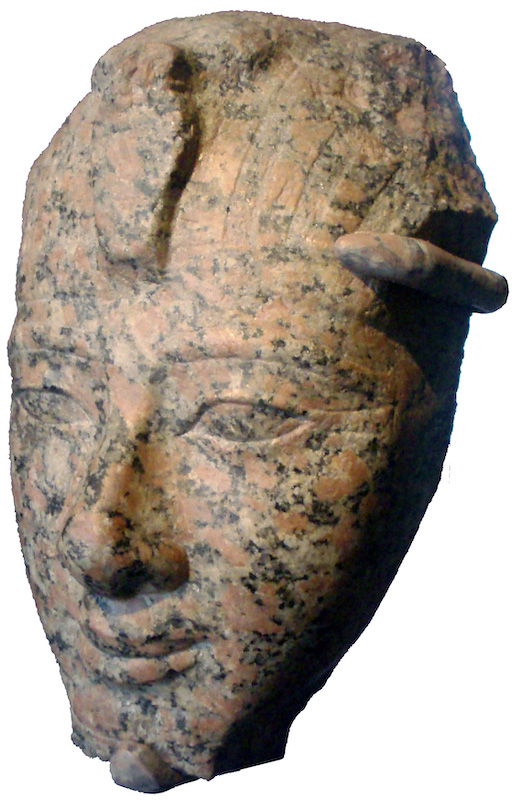
Fig. 6. Pharaoh Amenhotep II statue head, Brooklyn Museum. Keith Schengili-Roberts “Statue head of Amenhotep II,” https://en.m.wikipedia.org/wiki/File:AmenhotepII-StatueHead_BrooklynMuseum.png. CC BY-SA 2.5.
We have been progressively moving various points on the secular timeline forward, starting with Abraham at the beginning of the First Dynasty of Egypt. But now, having brought Shishak/Amenhotep II forward from the fifteenth century B.C. on the secular timeline to the tenth century B.C. on the biblical timeline, all events from the fifteenth century B.C. (Egyptian) on will have to move forward into the first millennium B.C., some time after Rehoboam. That clearly crowds the first millennium greatly, and raises the question how we can possibly fit about 800 secular years into about 300 biblical years before the point at which the two timelines must merge around 600 B.C.
The solution lies with a cataclysmic series of political events that historians have trouble understanding because it was so unlikely.
6. Twelfth-Century Collapse of Nations: Prophecies of Jeremiah. Divergence 550+ Years
The twelfth-century Bronze Age Collapse (also called the Late Bronze Age collapse) of the nations around the Mediterranean is mentioned regularly by secular scholars in the literature (for example, see Mark 2019).14It is described by them as a major catastrophic event of history. But how and why the nations of the known world collapsed as they did remains a persistent scholarly mystery. This ancient world had been flourishing, and there was no visible reason for it to collapse. As the secular scholar Cline says (2014, 140),
. . . we need to admit that there is currently no scholarly consensus as to the cause or causes of the collapse of these multiple interconnected societies just over three thousand years ago.
He then goes on to list a number of possibilities that scholars consider: “attacks by foreign enemies, social uprising, natural catastrophes, systems collapse, and changes in warfare.”
This collapse of nations is something that I also had puzzled over every now and then. Surely something as calamitous as this would show up in the Bible somewhere? As I mentally went over Old Testament events, nothing seemed to stand out as a possibility. But as I suddenly discovered one day when reading the Bible, I had been missing something. This collapse is predicted clearly in the Bible, in Jeremiah’s prophecies (Jeremiah 25:15–26):
For thus saith the Lord God of Israel unto me; Take the wine cup of this fury at my hand, and cause all the nations, to whom I send thee, to drink it. And they shall drink, and be moved, and be mad, because of the sword that I will send among them.
Then took I the cup at the Lord’s hand, and made all the nations to drink, unto whom the Lord had sent me: To wit, Jerusalem, and the cities of Judah, and the kings thereof, and the princes thereof, to make them a desolation, an astonishment, an hissing, and a curse; as it is this day; Pharaoh king of Egypt, and his servants, and his princes and all his people; And all the mingled people, and all the kings of the land of Uz, and all the kings of the land of the Philistines, and Ashkelon, and Azzah, and Ekron, and the remnant of Ashdod, Edom, and Moab, and the children of Ammon, and all the kings of Tyrus, and all the kings of Zidon, and the kings of the isles which are beyond the sea, Dedan, and Tema, and Buz, and all that are in the utmost corners, and all the kings of Arabia, and all the kings of the mingled people that dwell in the desert, And all the kings of Zimri, and all the kings of Elam, and the kings of the Medes, And all the kings of the north, far and near, one with another, and all the kingdoms of the world, which are upon the face of the earth: and the king of Sheshach shall drink after them.15
And when all these nations drink this wine cup of God’s fury, what is going to happen? God has ominous words for them in the remainder of this chapter: (verse 27) “Drink ye and be drunken, and spue (that is, vomit) and fall, and rise no more, because of the sword which I will send among you”; (verse 29) “I will call for a sword upon all the inhabitants of the earth”; (verse 32) “Behold, evil shall go forth from nation to nation, and a great whirlwind shall be raised up from the coasts of the earth”; (verse 37) “And the peaceable habitations are cut down because of the fierceness of the oppressor, and because of his fierce anger.”
This graphic description of Jeremiah’s prophecy sounds very much like the twelfth-century B.C. collapse of nations that has mystified the scholars of secular history. Cline tells us (2014, 9),
There seems little doubt that terror must have prevailed throughout the lands in the final days of these kingdoms.
I have used Cline’s chosen date of 1177 (2014, 1, 2) in fig. 1 to represent the beginning of the collapse of the Bronze-age nations. As he notes, there is variation among scholars on this date. See fig. 7 for a map showing proposed details of this collapse.

Fig. 7. Map of the eastern end of the Mediterranean world showing the twelfth-century B.C. Late Bronze Age collapse of nations and possible population movements. Jeremiah’s prophecy of Jeremiah 25 refers to this collapse, according to this paper’s timeline revision. Lommes, “Map showing the Bronze Age collapse (conflicts and movements of people),” https://commons.wikimedia.org/wiki/File:Bronze-age-collapse.svg. CC BY-SA 4.0.
Jeremiah began to prophesy in 628 B.C. (Jones 2004, 280) (biblical timeline); we do not know how long after that date that the earth-shaking events he predicted started to take place. If, however, we take this date of 628 B.C. and subtract it from the secular beginning of the collapse (in the vicinity of 1177 B.C.), we get a minimum of 549 years of divergence of the two timelines. This 550+ years is just about the difference between the Egyptian and biblical timelines that we are looking for in this time period. It should be noted that this collapse of the nations would have occurred over a period of years and is not a point synchronization. As Cline says (Cline 2014, 10),
. . . their cumulative demise spans several decades and perhaps as much as a century.
We note that Assyria is not mentioned by Jeremiah in the passage above. Historians tell us that the Babylonians and Medes caused the final demise of Assyria in about 609 B.C., although it had been declining since 626 B.C. (Finegan 1979, 118–126). This would mean that Assyria was no longer a power by the time of Jeremiah’s prophecy. As noted above, Babylon (Sheshach) is mentioned, as the last of the nations to fall, which it did to Cyrus the Persian in 539 B.C. (Finegan 1979, 133).
The famous Rameses II (Nineteenth Dynasty) would have died just before the beginning of the Bronze Age Collapse.
Secular scholars claim that there was a Third Intermediate Period from 1069–664 B.C. (Shaw 2003, 485) when there was decline and political instability in Egypt, which fragmented. There is doubt when exactly the pharaoh Sheshonq I (see no. 5 above) actually ruled, and what part of Egypt he ruled over. This pharaoh is located in the fragmented and uncertain Third Intermediate Period (see Shaw 2003, 486), and would have reigned sometime after Jeremiah’s prophecy, hundreds of years after Shishak of the Bible.
Moving the collapse of the nations of the twelfth-century B.C. secular timeline forward 550+ years to Jeremiah’s time plays havoc with the standard secular Egyptian history accepted by scholars today. We cannot work out the details on all this here. We can say that the so-called Third Intermediate Period of the first millennium B.C. must not have been anything like what the standard timeline looks like. Secular scholars have put together a pharaonic history that fills the centuries of time that we are taking out here.16
7. Pharaoh Necho II/Josiah/Jehoiakim (609 B.C., 605 B.C.)
There is a specific crossover point between the timelines when Pharaoh Necho II on his first military campaign slays King Josiah in 609 B.C. (Jones 2004, 280; Shaw 2003, 372; Thiele 1994, 180). Jehoahaz son of Josiah then became king. In the same year, Necho took Jehoahaz’ brother Eliakim and made him king instead, and renamed him Jehoiakim. For the biblical account of all this, see 2 Kings 23:29–35; also 2 Kings 24. In fig. 8 we see Tell Megiddo, where Necho II killed Josiah.
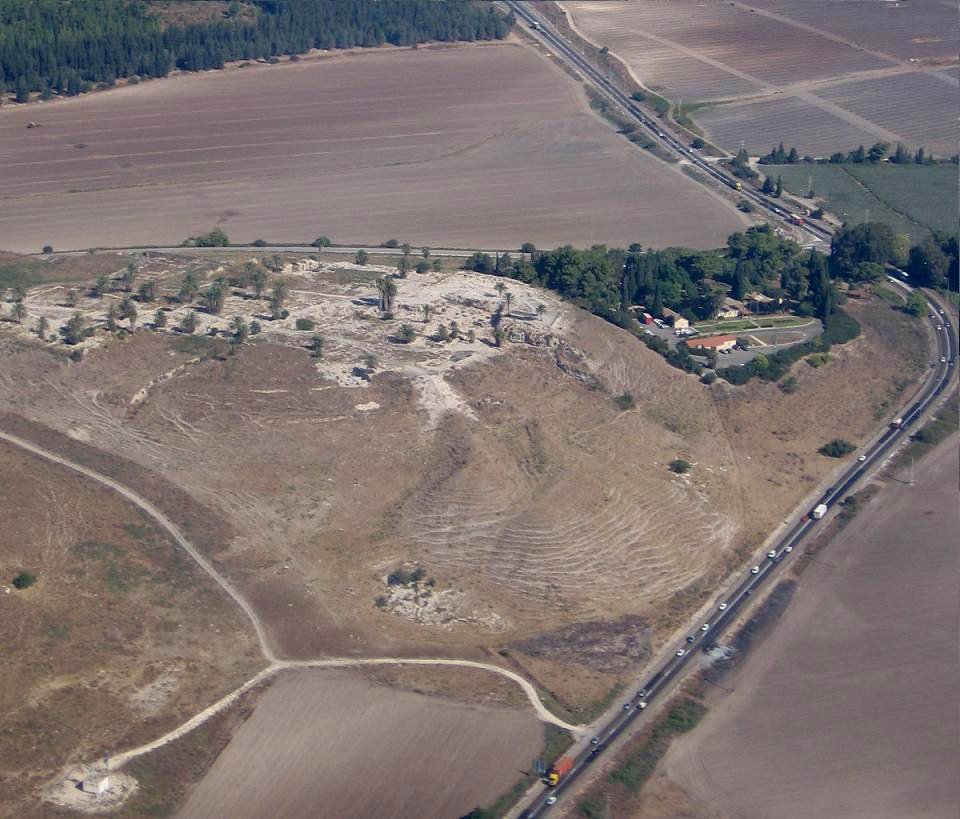
Fig. 8. Tell Megiddo in northern Israel where Pharaoh Necho II killed Josiah in battle (2 Kings 23:29). he-wiki, “Tel Megiddo.” https://commons.wikimedia.org/wiki/File:Tel_megido.JPG.
In a second very close crossover, Pharaoh Necho met Nebuchadnezzar at Carchemish in the fourth year of Jehoiakim in the year 605 B.C. (Jones 2004, 280) (Jeremiah 46:2). Therefore there are two Egyptian/biblical synchronizations close together in 609 and 605 B.C., that we will count essentially as one.
These events most likely took place during the beginning of the collapse of the nations described above in synchronization no. 6.
When the Two Timelines Merge
It is generally believed that the biblical and secular timelines merge in 586 B.C. at the time of the destruction of Jerusalem by Nebuchadnezzar II (Babylonians) (Jones 2004, 280). But as shown above, the Egyptian and biblical timelines effectively coincide 23 years earlier at 609 B.C. when Necho II kills Josiah. The biblical and Egyptian dates for this event are the same.
Other Possible Crossovers
The first millennium B.C. is complicated by what is called the Third Intermediate Period, when Egypt fragmented and several pharaohs may have been ruling at the same time. Examples of potential crossovers from the Egyptian timeline are the two named pharaohs, So (2 Kings 17:4) and Hophra (believed to be Apries of the Twenty-sixth Dynasty, mentioned in Jeremiah 44:30). Tirhaqah, king of Ethiopia (2 Kings 19:9, Isaiah 37:9), is believed to be Taharqa, who became a Twenty-fifth-Dynasty pharaoh ruling over Egypt and Cush, presumably later on. (See Shaw 2003, 485–487 for a list of the pharaohs of this period). More work needs to be done on determining how these pharaohs fit with biblical events.17
After Pharaoh Necho’s defeat in 605 B.C., Egypt is mentioned in Ezekiel 29:18–20 when God says that He will give over Egypt to Nebuchadnezzar to plunder as wages for his army because of the cost of his long siege of Tyre. However, the Bible does not tell us when Nebuchadnezzar actually did this, and the secular history is vague.
Warning About Mixing the Two Timelines
One of the errors to be studiously avoided is to use dates from both timelines in the same argument. For example, the famous Giza pyramids were built somewhat after 2600 B.C. on the standard secular Egyptian timeline (Shaw 2003, 482). On the biblical timeline those pyramids were built after Joseph/Imhotep, around 1650 B.C. (see fig. 1 to estimate this date). As shown in synchronization no. 1, Abraham’s visit to Egypt would have been about 3000 B.C. secular or 1900 B.C. biblical.18 This means that Abraham preceded the pyramids, and could not have seen them when he was in Egypt. We cannot say that the pyramids (2600 B.C. Egyptian) preceded Abraham (1900 B.C. biblical) because those two dates are taken from two different timelines.
Another example is the stele (stone slab) of the Pharaoh Merneptah, an object discussed regularly in the literature because of its mention of Israel. Merneptah reigned from about 1213 B.C. to 1203 B.C. secular (Shaw 2003, 485), and therefore scholars believe that this stele dates during the period of the judges—they are taking Merneptah’s date from the secular timeline and the judges date from the biblical timeline. Their discussion is whether Israel existed as a nation at that time (for example, see Kaltner 2021). This is no problem if the date of the stele is brought forward by several centuries into the first millennium B.C., as we are doing here, when Israel most certainly did exist as a nation. See fig. 9, a photo of this stele.
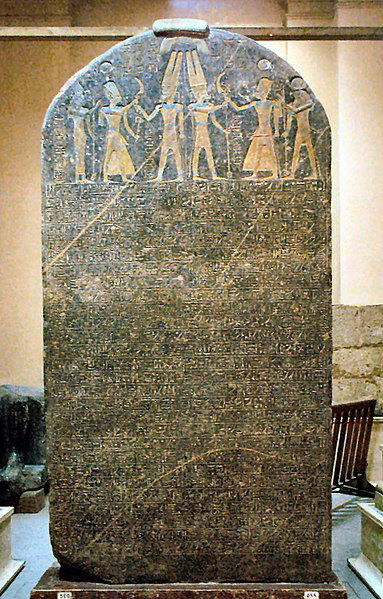
Fig. 9. Merneptah stele photo. This granite standing stone is inscribed by the Pharaoh Merneptah, who reigned from 1213 to 1203 B.C. (Egyptian timeline). In its last lines it mentions “Israel,” which has brought out a great deal of commentary from scholars, because they incorrectly believe the inscription dates to the time of the Judges. Found in Merneptah’s funerary chapel in Thebes, the stele is now located in the Egyptian Museum in Cairo. Webscribe, “Merneptah Stele known as the Israel stela (JE 31408) from the Egyptian Museum in Cairo.” https://en.m.wikipedia.org/wiki/File:Merenptah_Israel_Stele_Cairo.jpg. CC BY-SA 3.0.
The principle to keep in mind is that all published archaeological dates prior to about 600 B.C. are standard Egyptian dates, and are not the same as biblical dates.
A Note About Velikovsky
When Immanuel Velikovsky broke onto the chronology scene in 1952 with his book Ages in Chaos, the scholarly world showed great hostility to his ideas and continues to do so. Since then the shadow of Velikovsky has loomed largely over any chronology scheme that proposes the kind of divergence between the biblical and Egyptian timelines that this paper espouses. Indeed, there will be those who will claim that I am merely following Velikovsky here. I am not. All the material in this paper and my past papers on the subject has been developed entirely by me. There are elements in these papers that are similar to Velikovsky’s scheme, especially the amount of divergence of the two timelines from the Exodus on, because that’s where my arguments have led. But there are differences between my timeline and Velikovsky’s as well.19
Nonetheless I pay tribute to Velikovsky for his brilliant work and great courage in leading the way in exploration of this important field.
Final Words
The importance of synchronizing the Bible and Egyptian history correctly cannot be overemphasized. It is a primary tenet of biblical apologetics, as is shown by unbelievers who use secular archaeology dates to claim that the Bible is wrong, thereby undermining biblical veracity. If our Bible is not authoritative, we have nothing on which to base our faith.
References
Aharoni, Yohanan. 1979. The Land of the Bible: A Historical Geography. 2nd ed. Philadelphia, Pennsylvania: The Westminster Press.
Alexander, T. Desmond, and David W. Baker. eds. 2003. Dictionary of the Old Testament: Pentateuch: A Compendium of Contemporary Biblical Scholarship. Downers Grove, Illinois: InterVarsity Press.
Aling, Charles. 2003. “Joseph in Egypt: Part IV.” Bible and Spade 16, no.1:14.
Ashton, John, and David Down. 2006. Unwrapping the Pharaohs: How Egyptian Archaeology Confirms the Biblical Timeline. Green Forest, Arkansas: Master Books.
Bates, Gary, Robert Carter, Gavin Cox, and Keaton Halley. 2020. Tour Egypt. Powder Springs, Georgia: Creation Book Publishers.
Bryce, Trevor. 2005. The Kingdom of the Hittites. Oxford, England: Oxford University Press.
Bryce, Trevor. 2014. Letters of the Great Kings of the Ancient Near East: The Royal Correspondence of the Late Bronze Age. London , United Kingdom: Routledge.
Chetwynd, Tom. 1987. “A Seven-Year Famine in the Reign of King Djoser With Other Parallels Between Imhotep and Joseph.” Catastrophism and Ancient History 9, no. 1 (January): 49–56.
Cline, Eric H. 2014. 1177 B.C.: The Year Civilization Collapsed. Princeton, New Jersey: Princeton University Press,
Courville, Donovan A. 1971. The Exodus Problem and its Ramifications. Vols. 1 and 2. Loma Linda, California: Challenge Books.
Dee, Michael, David Wengrow, Andrew Shortland, Alice Stevenson, Fiona Brock, Linus Girdland Flink, and Christopher Bronk Ramsey. 2013. “An Absolute Chronology For Early Egypt Using Radiocarbon Dating and Bayesian Statistical Modelling.” Proceedings of the Royal Society A Mathematical, Physical and Engineering Sciences 469, no. 2159 (8 November): 20130395. https://www.ncbi.nlm.nih.gov/pmc/articles/PMC3780825/.
DeVries, LaMoine F. 1997. Cities of the Biblical World: An Introduction to the Archaeology, Geography, and History of Biblical Sites. Eugene, Oregon: Wipf and Stock.
El-Aref, Nevine. 2013. “Old Kingdom Leather Fragments Reveal How Ancient Egyptians Built Their Chariots.” ahramonline, 22 April. https://english.ahram.org.eg/NewsContent/9/40/69897/Heritage/Ancient-Egypt/Old-Kingdom-leather-fragments-reveal-how-ancient-E.aspx.
Finegan, Jack. 1979. Archaeological History of the Ancient Middle East. Boulder, Colorado: Westview Press, Inc.
Finkelstein, Israel, and Neil Asher Silberman. 2001. The Bible Unearthed: Archaeology’s New Vision of Ancient Israel and the Origin of Its Sacred Texts. New York, New York: The Free Press.
Gardiner, Alan H. 1964. Egypt of the Pharaohs. Oxford, England: Oxford University Press.
Greenberg, Gary. 2004. “Manetho: A Study in Egyptian Chronology: How Ancient Scribes Garbled an Accurate Chronology of Dynastic Egypt.” Marco Polo Monographs. Vol. 8. Edited by Sheldon L. Gosline. Warren Center, Pennsylvania: Shangri-La Publications.
Habermehl, Anne. 2013a. “Revising the Egyptian Chronology: Joseph as Imhotep, and Amenemhat IV as Pharaoh of the Exodus.” In Proceedings of the Seventh International Conference on Creationism. Edited by Mark F. Horstemeyer. Pittsburgh, Pennsylvania: Creation Science Fellowship.
Habermehl, Anne. 2013b. “Ancient Egypt, the Ice Age, and Biblical Chronology.” In Proceedings of the Seventh International Conference on Creationism. Edited by Mark F. Horstemeyer. Pittsburgh, Pennsylvania: Creation Science Fellowship.
Habermehl, Anne. 2017a. “Sodom—Part I.” Journal of Creation 31, no. 2 (August): 53–60.
Habermehl, Anne. 2017b. “Sodom—Part II.” Journal of Creation 31, no. 2 (August): 70–77.
Habermehl, Anne. 2018a. “Chronology and the Gezer Connection—Solomon, Thutmose III, Shishak and Hatshepsut.” Journal of Creation 32, no. 2 (August): 83–90.
Habermehl, Anne. 2018b. “The Ipuwer Papyrus and the Exodus.” In Proceedings of the Eighth International Conference on Creationism. Edited by John H. Whitmore. Pittsburgh, Pennsylvania: Creation Science Fellowship.
Henry, Roger. 2003. Synchronized Chronology: Rethinking Middle East Antiquity. New York, New York: Algora.
Herslund, Ole. 2018. “Chronicling Chariots: Texts, Writing and Language of New Kingdom Egypt.” In Chariots in Ancient Egypt: The Tano Chariot, A Case Study. Edited by André J. Veldmeijer and Salima Ikram. Leiden, Netherlands: Sidestone Press.
Iocco, Gregory. 2020. “Rameses III and Tel Lachish—A Test Case For the Egyptian Chronology of David Down.” Answers Research Journal 13 (July 29), 41–67. https://answersresearchjournal.org/rameses-iii-tel-lachish-david-down/.
Jack, James. 2016. “Akhenaten’s Monotheism and its Relationship with Ancient Hebrew Religion.” Armidale, Australia: University of New England.
James, Peter. 1993. Centuries of Darkness. New Brunswick, New Jersey: Rutgers University Press.
Jones, Floyd Nolen. 2004. The Chronology of the Old Testament. 16th ed. Green Forest, Arkansas: Master Books.
Kaltner, John. 2021. “Egypt.” Bible Odyssey. https://www.bibleodyssey.org/places/main-articles/egypt/.
Leprohon, Ronald J. 2013. The Great Name: Ancient Egyptian Royal Titulary. Atlanta, Georgia: Society of Biblical Literature.
Levy, Thomas E., Mohammad Najjar, Johannes van der Plicht, Thomas Higham, and. Hendrik J. Bruins. 2005. “Lowland Edom and the High and Low Chronologies: Edomite State Formation, the Bible and Recent Archaeological Research in Southern Jordan.” In The Bible and Radiocarbon Dating: Archaeology, Text and Science. Edited by Thomas E. Levy and Thomas Higham, 129–163. Sheffield, England: Equinox Publishing.
Lichtheim, Miriam. 1980. Ancient Egyptian Literature: A Book of Readings. Vol. III The Late Period. Oakland, California: University of California Press.
Lipschits, Oded, Yuval Gadot, and Matthew J. Adams. eds. 2017. Rethinking Israel: Studies in the History and Archaeology of Ancient Israel in Honor of Israel Finkelstein. University Park, Pennsylvania: Eisenbrauns.
Mark, Joshua J. 2019 “Bronze Age Collapse.” World History Encyclopedia. https://www.worldhistory.org/Bronze_Age_Collapse/.
Margueron, Jean-Claude. 1965. Mesopotamia. Trans. H. S. B. Harrison. Cleveland, New York City: The World Publishing Company.
McClellan, James E., and Harold Dorn. 2006. Science and Technology in World History: An Introduction. 2nd ed. Baltimore, Maryland: The Johns Hopkins University Press.
Moller, Lennart. 2002. The Exodus Case. Copenhagen, Denmark: Scandinavia.
Moore, Megan Bishop, and Brad E. Kelle. 2011. Biblical History and Israel’s Past: The Changing Study of the Bible and History. Grand Rapids, Michigan: William B. Eerdmans Publishing Co.
Osgood, John. 2016. The Times of Abraham and the Philistines. Queensland, Australia: John Osgood.
Osgood, John. 2020. They Speak With One Voice: A Correlation of the Bible Record with Archaeology. Queensland, Australia: John Osgood.
Ortiz, Steven. 2013. “Gezer.” In The Oxford Encyclopedia of the Bible and Archaeology. Edited by Daniel M. Master, 468–474. Oxford, England: Oxford University Press.
Podany, Amanda H. 2010. Brotherhood of Kings: How International Relations Shaped the Ancient Near East. New York, New York: Oxford University Press.
Piggott, Stuart. 1983. The Earliest Wheeled Transport: From the Atlantic Coast to the Caspian Sea. Ithaca, New York: Cornell University Press.
Porat, Naomi. 1992. “An Egyptian Colony in Southern Palestine During the Late Predynastic/Early Dynastic Period. The Nile Delta in Transition: 4th–3rd Millennium BC.” In Proceedings of the Seminar Held in Cairo, 21–24 October 1990, at the Netherlands Institute of Archaeology and Arabic Studies. Edited by Edwin C. M. van den Brink, 433–440. Tel Aviv, Israel: Netherlands Institute of Archaeology and Arabic Studies in Cairo.
Raffaele, Francesco. 2003. “Dynasty 0.” Aegyptiaca Helvetica 17, 99–141.
Rohl, David. 1995. A Test of Time. London, England: Century.
Rosenberg, Daniel, and Anthony Grafton. 2010. Cartographies of Time: A History of the Timeline. Hudson, New York: Princeton Architectural Press.
Shaw, Ian. 2003. The Oxford History of Ancient Egypt. New York, New York: Oxford University Press.
Smith, William. 1948. A Dictionary of the Bible. Teacher’s ed. Grand Rapids, Michigan: Zondervan Publishing House
Stiles, Wayne. 2020. “Pyramids of Giza—Astonishing Monuments and Painful Hopes: Those Moments When Egypt Sounds Better Than The Promised Land.” https://waynestiles.com/pyramids-of-giza/.
Stewart, Ted. T. 2003. Solving the Exodus Mystery. Vol. 1. Lubbock, Texas: Biblemart.com.
Sweeney, Emmet. 2008. The Genesis of Israel and Egypt. New York, New York: Algora.
Thiele, Edwin R. 1994. The Mysterious Numbers of the Hebrew Kings. Rev. ed. Grand Rapids, Michigan: Kregel.
Velikovsky, Immanuel. 2009. Ages in Chaos I: From the Exodus to King Akhnaton. London, England: Paradigma.
Velikovsky, Immanuel. 2010. Ages in Chaos II: Ramses II and His Time. London, England: Paradigma.
Velikovsky, Immanuel. 1977. Peoples of the Sea. Garden City, New York: Doubleday and Company, Inc.
Watrin, Luc. 1998. “The Relationship Between the Nile Delta and Palestine During the Fourth Millennium: From Early Exchange (Naqada I–II) to the Colonization of Southern Palestine (Naqada III).” In Proceedings of the Seventh International Congress of Egyptologists. Edited by Christopher J. Eyre, 1215–1216. Leuven, Belgium: Peeters Publishers and Department of Oriental Studies.
Wood, Bryant G. 2009. “The Number of Israelites in the Exodus.” Associates for Biblical Research. https://biblearchaeology.org/research/chronological-categories/exodus-era/3943-the-number-of-israelites-in-the-exodus.
